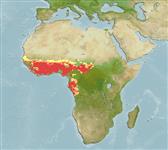Classification / Names
Common names from other countries
Issue
The species Chrysichthys furcatus Günther, 1864 is considered valid in Eschmeyer (CofF ver. Mar. 2012: Ref. 89686). It is treated here a synonym of Chrysichthys nigrodigitatus (Lacepède, 1803) following Risch (1992: Ref. 7324), Risch (2003: Ref. 57126) and Geerinckx et al. (2007: Ref. 81642).
Main reference
Size / Weight / Age
Max length : 65.0 cm SL male/unsexed; (Ref. 3236)
Length at first maturity
Lm ?, range 14 - ? cm
Environment
Freshwater; demersal; potamodromous (Ref. 51243); depth range 3 - ? m (Ref. 13851)
Climate / Range
Tropical; 22°C - 28°C (Ref. 12468), preferred ?; 15°N - 13°S, 16°W - 30°E
Distribution
Short description
Dorsal
spines
(total): 2;
Dorsal
soft rays
(total): 6;
Anal
spines: 0. Diagnosis: recognized by its pointed snout, the rather small mouth, and the width of the premaxillary tooth plate (1/5-1/3.5, usually 1/4, of head length); vomerine dentition represented by a square to rectangular tooth plate which begins to develop at sizes between 60 and 70 mm standard length; palatine dentition developing at sizes over 100 mm standard length, initially as isolated teeth; second or third branched dorsal-fin ray always the longest; upper caudal-fin lobe much longer than lower lobe; gill rakers long and smooth; other characters, such as length of dorsal fin, number of branched rays in anal fin, and number of gill rakers on first gill arch, are subject to intraspecific variations; sexually mature males and ripe females show considerable morphological differences; such specimens have often been labelled as Chrysichthys furcatus; maturity occurs probably at a rather advanced stage (at over 200 mm SL) and leads to the inflation of head, broadening of mouth and premaxillary tooth plate, shortening of spines and overgrowth of fin-spines by thick skin, the fins becoming more rounded, and the caudal-fin lobes sometimes becoming subequal; the body acquires an emaciated appearance (Ref. 57126).
IUCN Red List Status (Ref. 115185)
Threat to humans
Harmless
Human uses
Fisheries: minor commercial; aquaculture: commercial; gamefish: yes; aquarium: public aquariums
Tools
Special reports
Download XML
Internet sources
Estimates of some properties based on models
Phylogenetic diversity index
PD50 = 0.5000 many relatives (e.g. carps) 0.5 - 2.0 few relatives (e.g. lungfishes)
Trophic Level
3.2 ±0.41 se; Based on food items.
Resilience
Medium, minimum population doubling time 1.4 - 4.4 years (K=0.12-0.65; Fec = 3,086-28,086)
Vulnerability
High vulnerability (60 of 100)
Price category
